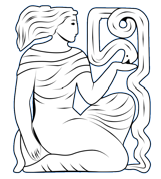| Dr. Jane Brooks, University of Manchester | The UKAHN Bulletin |
| Volume 8 (1) 2020 | |
 Many historians of nursing will know of La Motte’s war work through the work of Christine Hallett, some may have read La Motte’s own The Backwash of War. La Motte’s work as a public health nurse, a suffrage activist and her crusade against the opium trade are perhaps less well known. Lea M. Williams’ new monograph sets out in scrupulous detail these other fascinating aspects of this early twentieth century polymath. In the introduction to the book, Williams points to the range of La Motte’s work and what she refers to as her ‘ever-changing interests’(p 2). However, as one continues to read, it becomes clear that the diversity of issues that claimed her working-life are not so much ‘ever-changing’ as part of a narrative that for La Motte is about public welfare.
Many historians of nursing will know of La Motte’s war work through the work of Christine Hallett, some may have read La Motte’s own The Backwash of War. La Motte’s work as a public health nurse, a suffrage activist and her crusade against the opium trade are perhaps less well known. Lea M. Williams’ new monograph sets out in scrupulous detail these other fascinating aspects of this early twentieth century polymath. In the introduction to the book, Williams points to the range of La Motte’s work and what she refers to as her ‘ever-changing interests’(p 2). However, as one continues to read, it becomes clear that the diversity of issues that claimed her working-life are not so much ‘ever-changing’ as part of a narrative that for La Motte is about public welfare.
Chapter One considers La Motte’s entrée into nursing at the Johns Hopkins Training School for Nurses in 1898. Although like many young women of her social status who wished to train as a nurse, La Motte’s family did not initially approve, but Johns Hopkins was the choice for young women of rank who wished to enter the profession and she flourished in the company of other like-minded and intellectually curious women. On ‘graduating’ La Motte worked in a number of nursing positions, as a supervising nurse at Johns Hopkins Hospital, a private duty nurse in Italy and an operating nurse in St Louis, before turning her attention to what would occupy her professional life for nearly a decade: tuberculosis. It is through this work that Williams first makes La Motte’s contradictions apparent. As a nurse, La Motte may perhaps be expected to care for her individual patients and as a crusader against this most virulent of diseases, a reader may expect sympathy, but we are presented with neither. TB must be eradicated, but in direct opposition to elite nurses such as Adelaide Nutting, La Motte did not think education was beneficial. In an article to the Maryland Medical Journal in 1909, she called for ‘more radical measures’ to prevent disease. As Williams maintains, the nurse was now ‘a mediator of social control, a representative of her class and race interests’(p.35).
By 1910, Chapter Two maintains, La Motte was moving her interests to the suffrage campaign. In this campaign, as in that to neutralise TB, her class and race prejudices come to the fore. La Motte like many of her compatriots saw women’s franchise not as a method of gaining ground into men’s world, but as a way to create better wives and mothers. However, this was a particularly white narrative. New Voter (a publication launched to support the suffrage movement, with which La Motte was connected) made little or no attempt to galvanise the Africa American woman to fight for franchise. By 1912, La Motte was making herself unpopular in her suffrage work, when she criticised Maryland suffragists for not entering the parade set for June in that year. But she saved her most palpable frustrations for Southern Belles and their anti-suffrage lobby, who by their own admission, ‘tremble at the sound of our own voices in public’(p.51). In August 1914, after a stint in England learning from militant suffragettes and writing about their activities in Baltimore’s Sun, she returned to the USA, only to sail to Paris in October.
La Motte’s arrival in Paris leads Chapter Three to explore her search for ‘meaningful work’ and her quest to work as a war nurse. This period also brought her into contact with artists and the avant-garde, particularly Gertrude Stein and Alice B. Toklas, with whom she maintained correspondence into the 1930s. Although La Motte’s most famous work is her war work, Williams does not introduce us to fellow war nurse, Mary Borden, until p105. The late meeting in this book is an important one, it enables the reader to set La Motte’s war nursing in a developing understanding of a woman with multiple talents and a broad range of interests. La Motte was forced to wait many months for her call to the front and did not ultimately leave until June 1915. Nevertheless, with the hospital not ready and no patients for whom to care, she and other nurses were left to wait. Eventually she had to return to Paris to procure documents to enable her to work in a war zone. Thus, about six months after she began her efforts to seek a nursing position, La Motte received her orders to report to L’Hôpital Chirurgical Mobile No.1.
Chapter Four examines La Motte’s work on the frontlines. Perhaps because of the extreme effort to get there, or perhaps because of her perfectionist personality – most likely a combination of both – La Motte did not find the work as satisfying as she had hoped. As William’s argues, she experienced, ‘a myriad of vexations brought on by different nursing standards and cultural differences’(p 119). It is this work that creates the sketches that are later published in The Backwash of War, but which leads to further antagonism with her nursing colleagues and the American Press. Her criticisms of the pointlessness of their work, that patches men up to return them to war and the complicity of nurses and doctors in the machinery of the frontline, did little to persuade her colleagues of her loyalty.
The final chapter in this monograph explores La Motte’s campaign against the opium trade. Given her notions of white superiority, it does at first seem odd that she would side with the Chinese against their British ‘masters’. But in this, as in her other campaigns, it is precisely the superiority of the European that renders them responsible for the care and guidance of those they rule. In a typically blunt passage in her 1917 publication, Peking Dust, La Motte wrote of the: ‘The sweepings and refuse of Western Civilization and Western morality [which] are dumped out upon the Orient, where they do not show’(p 165). Such rhetoric was not well received and it was not until the 1930s that La Motte was recognised for her work.
Throughout this detailed and meticulously researched monograph, Williams sets centre stage a woman who is clever, difficult and driven. In her relationships of love, as with her campaigns, Williams bears witness to La Motte as faithful to the cause, if perhaps unlikeable. Williams is to be commended most highly on using both the full range of La Motte’s own writings as well as writings by others to bring to bear the life of this fascinating and motivated woman: a nurse, writer and activist.
